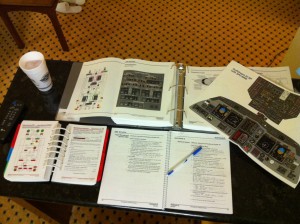An airplane is a lot like an onion: there are countless layers to peel back. Iâ€Image may be NSFW.
Clik here to view. ve been flying the Gulfstream IV-SP for five years now, and on every trip I learn something new. Most recently a mechanic informed me that it was legal to fly the airplane with one of the wingtips missing! Howâ€Image may be NSFW.
ve been flying the Gulfstream IV-SP for five years now, and on every trip I learn something new. Most recently a mechanic informed me that it was legal to fly the airplane with one of the wingtips missing! Howâ€Image may be NSFW.
Clik here to view. s that for a revelation?
s that for a revelation?
The one constant in the life of every professional aviator is learning. We have to be experts on aviation law, meteorology, aerodynamics, aircraft systems, human physiology, aeronautical decision-making, and dozens of other topics. Much of our learning occurs through practical experience, but even after reaching the highest certificate and rating status, we still undergo regularly scheduled and federally mandated training of one sort or another. We simply are not allowed to fly without it.
Clik here to view.

Every six months I head to Dallas for a long week of recurrent ground and simulator training on the Gulfstream. We review every aircraft system, from hydraulics and electrics to pressurization, engines, fuel and oil systems, and more. We then get to experience various failures and extreme flying conditions in a full motion simulator. The week ends with oral and practical testing. Then there are the international procedures training, emergency training, courses on FAA regulations and company policies, hazardous materials handling, TSA/security procedures, CPR training, and so on. As a flight instructor, I also take a refresher course on teaching fellow pilots every 24 months.
Pilots take this stuff pretty seriously. Many of us go beyond the required elements, pursuing what I call ‘electivesâ€Image may be NSFW.
Clik here to view. . For instance, I frequently fly tailwheel and aerobatic aircraft in order to keep my manual flying skills at the highest possible level and ensure Iâ€Image may be NSFW.
. For instance, I frequently fly tailwheel and aerobatic aircraft in order to keep my manual flying skills at the highest possible level and ensure Iâ€Image may be NSFW.
Clik here to view. m fully prepared to deal with any upsets caused by windshear, wake turbulence, autopilot malfunction, severe weather, or other causes.
m fully prepared to deal with any upsets caused by windshear, wake turbulence, autopilot malfunction, severe weather, or other causes.
Clik here to view.

Pilots share experiences, delve into maintenance manuals, and read aviation magazines. Weâ€Image may be NSFW.
Clik here to view. re even known to pore over accident reports. It sounds morbid, but learning what not to do can be as powerful and important a lesson as anything youâ€Image may be NSFW.
re even known to pore over accident reports. It sounds morbid, but learning what not to do can be as powerful and important a lesson as anything youâ€Image may be NSFW.
Clik here to view. ll find in a textbook. You never know what tiny morsel of information might save the day when the chips are down. When you put it all together, the final result is what FlightSafety refers to as “the best safety device in any aircraftâ€: a well-trained pilot.
ll find in a textbook. You never know what tiny morsel of information might save the day when the chips are down. When you put it all together, the final result is what FlightSafety refers to as “the best safety device in any aircraftâ€: a well-trained pilot.
It can be difficult to reconcile all the training Iâ€Image may be NSFW.
Clik here to view. ve taken over the years with the fact that I still donâ€Image may be NSFW.
ve taken over the years with the fact that I still donâ€Image may be NSFW.
Clik here to view. t “know it allâ€. But because aviation is so unforgiving of carelessness or inattention, the learning must continue. In a larger sense, itâ€Image may be NSFW.
t “know it allâ€. But because aviation is so unforgiving of carelessness or inattention, the learning must continue. In a larger sense, itâ€Image may be NSFW.
Clik here to view. s part of the human condition. Much like a flower, a human cannot remain static. Weâ€Image may be NSFW.
s part of the human condition. Much like a flower, a human cannot remain static. Weâ€Image may be NSFW.
Clik here to view. re either blooming or wilting.
re either blooming or wilting.
I remember the day I earned my pilot certificate. It was a beautiful Christmas Eve nearly two decades ago, but it still feels like yesterday. The examiner sat me down and solemnly said that the piece of paper she was handing me wasnâ€Image may be NSFW.
Clik here to view. t proof that I had reached the pinnacle of flight, but rather was simply a “license to learnâ€. Iâ€Image may be NSFW.
t proof that I had reached the pinnacle of flight, but rather was simply a “license to learnâ€. Iâ€Image may be NSFW.
Clik here to view. ve tried to take that message to heart, and as I got into my car, still floating on cloud nine after my check ride success, I promised myself that the day the learning stopped, it would be the sign: I’d hang up my headset and walk away from the cockpit for the last time.
ve tried to take that message to heart, and as I got into my car, still floating on cloud nine after my check ride success, I promised myself that the day the learning stopped, it would be the sign: I’d hang up my headset and walk away from the cockpit for the last time.
This article first appeared in the November, 2016 issue of Jetgala Magazine.
